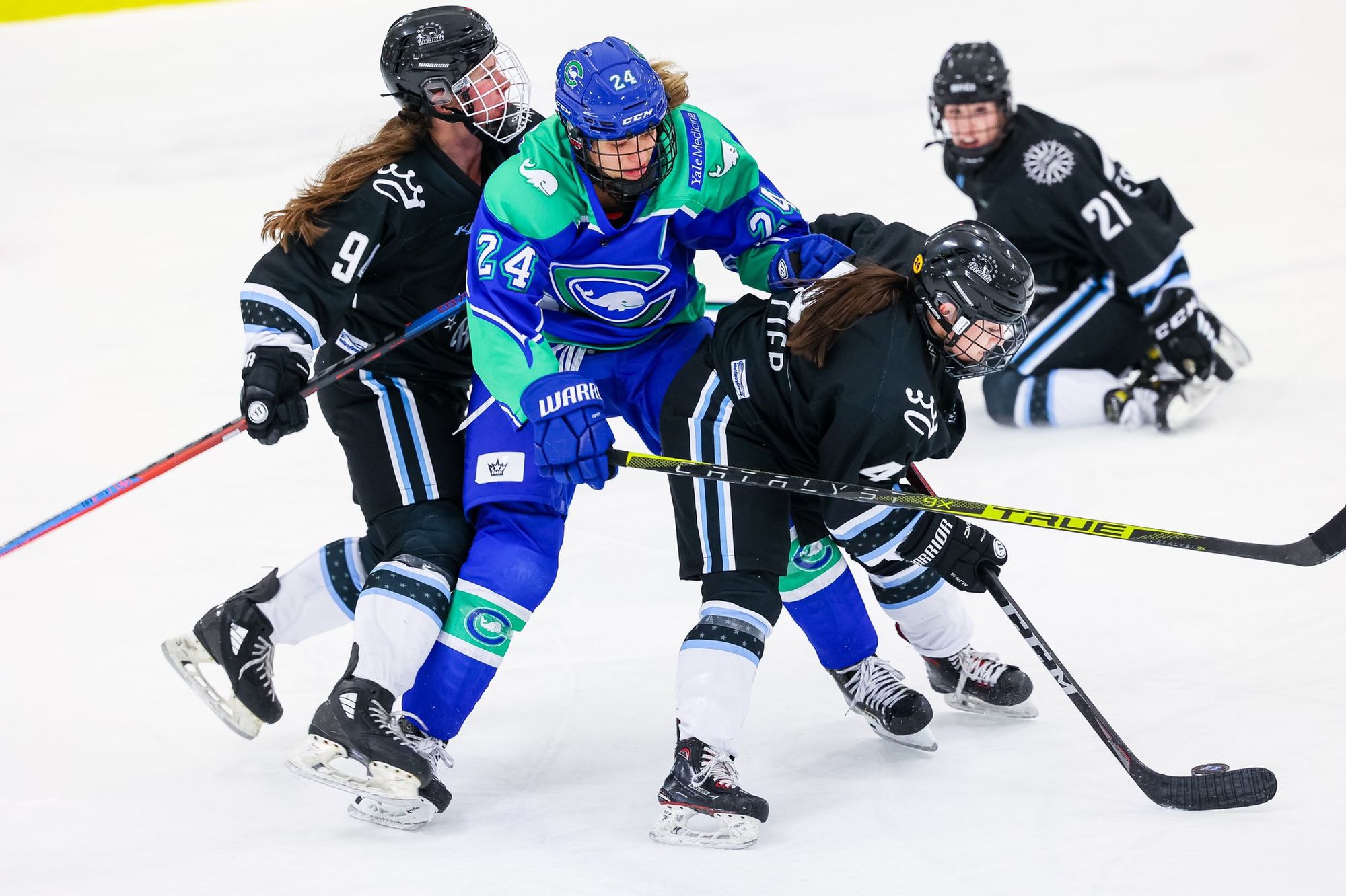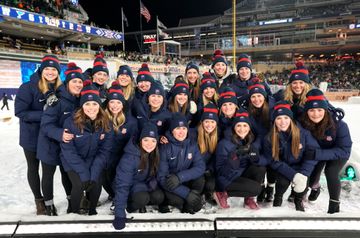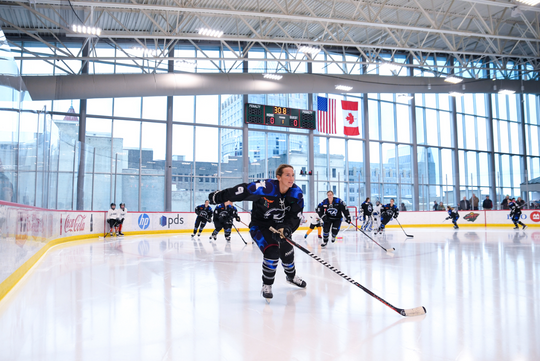The Premier Hockey Federation (PHF) recently announced a $25 million commitment to invest in the federation by its Board of Governors over the next three years. The commitment includes a $7+ million investment for the 2022-23 season, which, according to their release, will significantly raise team salary caps, provide full healthcare for players, and fuel much-needed facility updates.
"The nature of the $25 million investment represents a collective commitment being made by the Board of Governors over the next three years," said Chairman John Boynton. Boynton is also part of BTM Partners, LLC, which owns the Boston Pride, Toronto Six, and Metropolitan Riveters.
The Board of Governors consists of six voting members who represent team ownership groups: Miles Arnone (Boston); John Boynton (Metropolitan); Johanna Boynton (Toronto); Tobin Kelly (Connecticut); Neil Leibman (Minnesota) and Andy Scurto (Buffalo).
"Owners are independently contributing their own financial resources to enhance the player experience and help players earn a livable wage playing the game they love," Boynton added. "This will raise the professionalism, exposure, and overall profile of the PHF and its teams."
Salary Cap Increase & Benefits
With the investment, the PHF will more than double its salary cap per team, from $300,000 to $750,000, for the 2022-23 season. There will be no minimum or maximum player salary and no salary floor that teams will be required to reach.
Future salary cap values will be determined on an annual basis.
Player salaries have not been disclosed for several seasons, so it's hard to know exactly what players are earning, how close they are to a living wage, or how much teams are actually spending against their cap. Unfortunately, this doesn't appear to be changing any time soon.
"At this time it remains the Federation's position that player salaries are not to be disclosed," Boynton said, when asked if the PHF has any plans for improved transparency with regards to player salaries.
The PHF continues to build a joint venture model, with teams independently owned and operated. Each club will continue to be responsible for team expenditures, including player salaries and benefits, within the federation's expectations and requirements.
In addition to the salary cap increase, new player contracts will introduce full healthcare coverage, something the PHF has never offered. Currently, contracts cover workers' compensation for hockey-related injuries only. The boost to offering full healthcare is an important step toward allowing players to make hockey their full-time job.
"The Board of Governors is united in the view that health insurance coverage is an essential component of a professional employment package," Boynton said. "The actual design of the insurance program has not been finalized, and regulation can vary materially from state to state and country to country, but it's reasonable to assume that the packages will be comparable across the teams."
A parental leave policy is also expected as part of the planned benefits package, with details to be finalized by the time players are asked to sign contracts for the next season, per Boynton.
"Salaries and benefits are, and will continue to be, the most important cost driver for the Federation," Boynton said. "The increase in the salary cap that was announced on Monday is a big step, but not the last step, on the compensation front. I think we can all agree that we hope to see PHF players compensated even better in the future."
If there are indeed eight teams next season (more on that below), the current investment would include about $6 million for salaries and $1.5 million for benefits.
Equity, Facility Improvements & Staffing
In correlation with the recently-announced investment came the news that players will receive a 10% equity stake, designed to enable players to share in the PHF's financial success. Further details on the mechanics of the equity share – such as what type of investment unit it is, and how players can draw from the fund – will be provided in the future, but per Boynton, it is a 10% equity stake of all teams combined:
"Our expectation is that each team will contribute 10% of its equity to a pool for the benefit of the players," he said. "While the concept is simple, the implementation will require legal and accounting support to ensure that the investment vehicle achieves its goal of providing our players the opportunity to share in the value that is built over time."
Per the PHF release, the investment is also designed to assist in providing updated facilities for players. Several players over the course of this season, for instance, have noted the need for better rink pegs to hold nets into place. While the PHF does not own or operate the rinks it plays in, the federation expects to work with their facilities to improve the player experience.
"Professional infrastructure is an important part of the player experience and something all owners are prioritizing," Boynton said. "We share the goal of providing the best possible resources for our athletes and recognize the need for improvement within our facilities... Conversations are ongoing with local partnerships where needs may differ across all organizations."
Boynton pointed out locker room upgrades in Connecticut and Toronto as examples of recently facility updates.
While the focus is largely on player salaries and the player experience, many have asked if the investment will also be used to boost team staff pay or provide for infrastructure such as improved statistics or record-keeping.
The Federation's official statistics as posted online have often been incorrect, requiring independent corroboration or clarification. Whether it's goals and penalties being incorrectly recorded or goaltenders not having any stats at all after a game, sometimes for several days, it's an area that leaves room for improvement.
"This investment has been committed towards direct payments and benefits to the players, but we expect that all aspects of the hockey operations will continue to improve alongside our competition increase," Boynton noted.
Expansion.. and More!
Buried amid the investment news release was an official announcement of the Federation's plans for expansion, including finally adding a team in Montreal, Quebec, for the 2022-23 season.
Messaging from the PHF was a bit unclear, as their press release noted "the potential for additional clubs to broaden its United States footprint," while an accompanying video explicitly noted a forthcoming expansion to eight teams. Asked for clarification, Boynton said it is the Federation's goal to expand to eight teams for the upcoming season, and that more details about Montreal and an additional United States team will be shared at the appropriate time.
Boynton also shared with Alex Azzi of On Her Turf that he hopes to see further expansion to ten teams in the 2023-24 season.
Communication
The PHF puzzled many when it sent out a media advisory at 7:00 PM Eastern on Monday, January 18, noting a "major announcement" to be made "regarding its future in the sport" just twelve hours later. Players were not informed of an expected announcement, nor of its contents, and found out about the investment at the same time as fans and media.
Although players are rightfully very excited about the investment and expansion news, many throughout the women's hockey community expressed concern that players weren't given any kind of heads-up, or at least a note that it wasn't negative news being shared. Given how suddenly the news of the CWHL's demise came out in 2019, the handling of this announcement – and the vague language used in the advisory, which could have meant almost anything – left a bitter taste and caused panic for some.
When asked about this choice, Boynton commented: "Our process ensured that only the most detailed and accurate information about the full nature of the commitment would be communicated by the PHF and the Board of Governors in a manner that provided equal access for all of our athletes and stakeholders."
He also noted that owners have been meeting individually with their teams, and that the response from players has been overwhelmingly positive.
This investment is significant, and the commitment for the future is, too. How it is put into action, how much the player experience improves and what it does for the league and sport as a whole will be key points to watch going forward.
Update: Below are the questions we submitted, and subsequent answers received, from the PHF Player's Association:
When and how were players informed of this investment? After the announcement, team owners made themselves available to their respective players to answer any questions the players had on this historic announcement.
Will the PHFPA be working with the Board of Governors in order to determine areas of greatest need that should be prioritized with this investment? The Players' Association welcomes collaborating with the Board of Governors on the commitments that were recently announced to grow the game and our league with the best interests of our members at heart. Before the announcement, Executive Director Sinatra tasked all members with creating their top 3 needs and top 3 wants as they relate to their employment.
Is there any plan to increase public transparency about player compensation (salary and benefits)? We are unaware of a plan to increase public transparency about player compensation. That question is best directed to the Commissioner's Office.
Does the PHFPA have a stance on player benefit standards? We have asked the PHF and Board of Governors if the "full healthcare benefits provided by their club" will be standard across the league. We are working with our members on a framework for this.
(Photo: Mike Hetzel/Buffalo Beauts)


![The Post-Capitalist Sports Future: Sports Cryptocurrency Tokens are the Natural Conclusion of an Economy That Is About Nothing [PART 1]](/content/images/size/w360/2022/01/shubham-dhage-dVcXOkpp3fk-unsplash.jpg)




